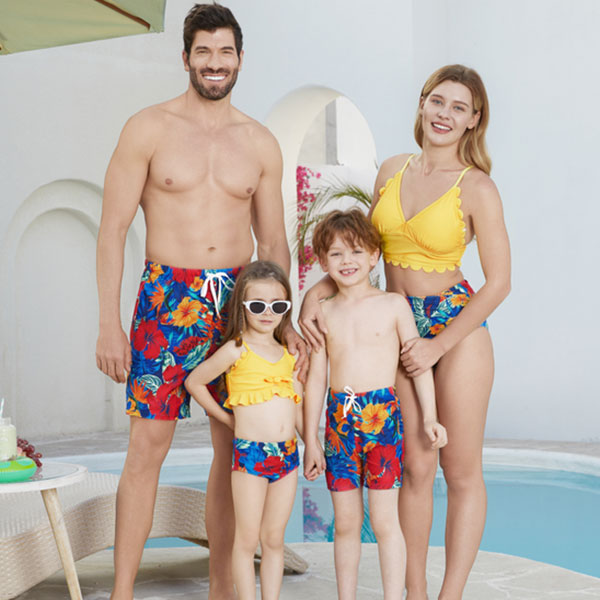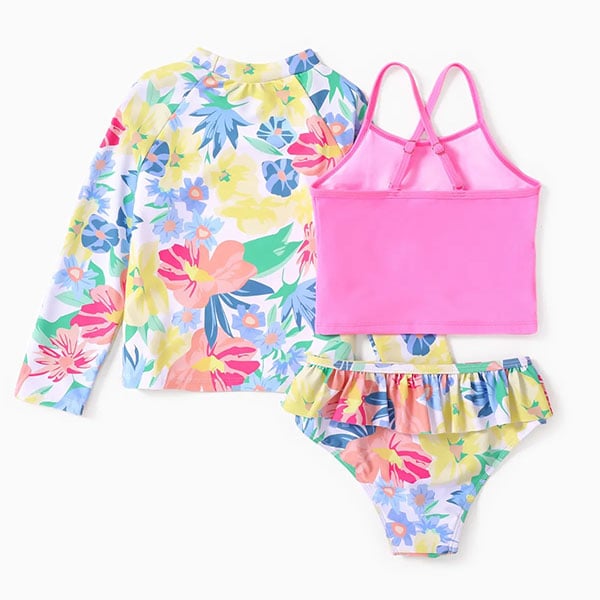Have you ever considered what makes a swimsuit durable and comfortable? Most people pay close attention to design, fit, and color when searching for the ideal swimsuit. The swimsuit fabric is also very important.
Many swimsuit materials have different breathability, durability, chlorine resistance, and stretch degrees. While certain fabrics have excellent shape retention, others dry rapidly. Knowing the material will help you choose a bathing suit fabric that fits your body, resists fading, or holds up against repeated pool dips.
The most often used swimsuit fabrics, their unique qualities, and how they affect your swimwear experience will be covered in this blog. We will also give a score to every material according to important criteria: stretch, durability, chlorine resistance, and drying speed.
So, if you’re wondering which swimsuit fabric is best for you, read on to find out! Also, Check out the latest Patpat swimwear collection for you and your family.
Nylon (Polyamide) – The Lightweight & Stretchy Favorite
What Is Nylon?
The synthetic fabric nylon serves as one of the main materials used for swimming suits under its alternative name polyamide. The synthetic material has a light weight and produces silky smooth textures together with a soft touch. The high flexibility rate makes nylon the preferred fabric option for swimwear that fits the body closely. The combination of nylon and Spandex results in swimwear that maintains fit quality while providing a comfortable snugness. Furthermore, providing an excellent wearing experience, nylon swimwear is breathable and feels wonderful against the skin.
Why Choose Nylon for Swimwear?
Soft & Comfortable
Ideal for all-day wear, nylon swimwear is relatively mild on the skin and incredibly smooth. It’s lightweight and ensures free movement, enabling you to enjoy resting or swimming quickly.
Quick-Drying
Nylon dries far faster than other materials since it absorbs relatively little moisture. Those who like hopping in and out of the water without feeling moist for extended durations may notably benefit from this ability.
Excellent Stretch
The natural elasticity of nylon ensures a tight but flexible fit, which makes it ideal for swimwear that must fit body movements. This feature also improves comfort and helps to stop gradual sagging.
Vibrant Colors
One of the nylon’s benefits is that it holds dye remarkably well, producing vivid, intense, fade-resistant colors. For fashionable and striking swimsuits, this makes it a great option.
Downsides of Nylon Swimwear
Low Chlorine Resistance
Less Durable
Ratings
Stretch & Comfort: 5 Stars
Durability: 3 Stars
Chlorine Resistance: 2 Stars
Drying Speed: 5 Stars
Best For
Nylon swimwear is perfect for light swimsuits, sunbathing, and laid-back beachgoing. If you adore spending time at the beach or resting by the pool, this fabric delivers maximum comfort and bright style. If you swim regularly in chlorine-treated pools, consider a more robust choice like Polyester for long-term usage.
Polyester – The Long-Lasting Champion
What Is Polyester?
The high-performance synthetic fabric Polyester gets frequently applied in swimwear because of its durable nature combined with superior chlorine resistance properties. The fabric of Polyester maintains structure superior to nylon thus it provides extended durability by resisting distortion and elongation. The material Polyester demonstrates outstanding colorfastness properties because it fights fading and pool chemicals and sunlight exposure while providing breathable comfort with moisture-wicking ability suitable for both recreational and competitive swimmers.
Why Choose Polyester for Swimwear?
Highly Durable
Excellent for swimwear that needs to last, Polyester is resistant to wear, drooping, and stretching. It keeps its original fit and construction even with regular wear.
Chlorine & UV Resistant
People who swim frequently should use polyester swimwear instead of nylon swimwear since polyester shows stronger resistance to chlorine destruction. The fabric protection from Ultra Violet rays helps minimize damage from the sun which in turn extends the fabric lifespan.
Fade-Resistant
Polyester ensures that colors remain vivid even after many swims by effectively clinging to dyes. Your swimsuit will keep its original brilliant and fashionable look in salted ocean water or chlorine pools.
Breathable & Comfortable
The fabric performs moisture-wicking to maintain sweat-free dryness while being worn in hot conditions. Polyester swimwear provides exceptional ventilation which reduces sweat quantities and discomfort because of humidity.
Downsides of Polyester Swimwear
Less Stretchy
Slightly Slower Drying Time
Ratings
Stretch & Comfort: 4 Stars
Durability: 5 Stars
Chlorine Resistance: 5 Stars
Drying Speed: 3 Stars
Best For
Pool enthusiasts, competitive swimmers, and regular swimmers all fit polyester swimsuits. The fabric offers such a strong resistance and color protection for outdoor and chlorinated pool use that your swimsuit can last many years with minimal deterioration.
Spandex (Lycra/Elastane) – The Flexibility King
What Is Spandex?
Spandex stands out as an excellent elastic synthetic fiber also known alternatively as Lycra or elastane. Spandex material has a unique property which enables it to stretch five times more than its initial length and maintain its original form unlike alternative swimsuit fabrics. Form-fitting swimwear which hugs the body correctly proves suitable when manufactured with this material. As a stand-alone material Spandex functions poorly but manufacturers blend it with Polyester and nylon for better durability along with outstanding comfort and flexibility.
Why Choose Spandex for Swimwear?
Super Stretchy
Unmatched flexibility from Spandex lets the fabric fit comfortably and conform to the body. Fashion-forward swimwear and active swimmers will find this perfect.
Form-Fitting
The capacity of Spandex to improve body curves and offer excellent form retention is among its main benefits. Spandex swimsuits produce a sleek, sculpted look that accentuates every body shape.
Flexible & Comfortable
Perfect for swimwear that calls for freedom of movement, Spandex gives a second-skin sensation. Whether your activities are swimming, diving, or tanning, it ensures a pleasant and free experience.
Downsides of Spandex Swimwear
Sensitive to Chlorine
Requires Blending
Ratings
Stretch & Comfort: 5 Stars
Durability: 3 Stars
Chlorine Resistance: 2 Stars
Drying Speed: 4 Stars
Best For
Competitive swimwear, high-performance swimsuits, and fashion swimwear requiring a snug, sculpted fit all call for Spandex as the go-to fabric. Spandex-blended materials are the ideal option for a swimsuit that accentuates your body and provides free movement.
Neoprene – The Best for Water Sports & Warmth
What Is Neoprene?
Neoprene functions as synthetic rubber material used especially for making wetsuits and high-end swim wear items. Due to its functionality in cold-water swimming neoprene swimsuit materials outperform typical swimwear products as they create warmth and bulkiness which withstands cold temperatures. The purpose of neoprene is to hold in body heat so that swimmers remain warm even when performing in cold water conditions. High buoyant properties of neoprene help swimming athletes stay afloat easily. Surface and cold water activities select neoprene as their ideal material because it shows outstanding resistance to wear and maintains its durability.
Why Choose Neoprene for Swimwear?

Provides Warmth
Perfect for cold-water swimming, diving, and winter surfing, neoprene is meant to hold body heat. It lowers heat loss in colder temperatures, therefore helping to prevent hypothermia.
Buoyant & Supportive
Neoprene’s intrinsic buoyancy helps you stay floating effortlessly, therefore facilitating swimming. Divers, surfers, and long-distance swimmers especially find this helpful.
Durable & Tear-Resistant
Neoprene is quite wear and tear resistant, unlike Spandex or nylon. One of the most long-lasting swimwear materials, it can resist frequent use, rocky surfaces, and strong waves.
Downsides of Neoprene Swimwear
Heavier than Other Fabrics
Less Breathable
Ratings
Stretch & Comfort: 3 Stars
Durability: 5 Stars
Chlorine Resistance: 4 Stars
Drying Speed: 2 Stars
Best For
For water sports, diving, surfing, and swimming in frigid temperatures, neoprene is the first choice. Professional and adventure swimmers who require additional defence against cold water and hostile environments will find the ideal fit for its insulating and buoyant qualities.
PBT (Polybutylene Terephthalate) – The Professional’s Choice
What Is PBT?
Competitive swimmers including those who use PBT (polybutylene terephthalate) high-performance swimwear fabric find it ideal because it merges improved flexible Polyester material with Professional swimwear requirements. PBT swimwear offers better chlorine resistance together with exceptional form retention in addition to its lightweight design. Swimmers choose PBT for its reliable performance and comfort due to its resistance in challenging aquatic environments which makes it suitable for competitive racing swimsuits and fitness swimwear products. Those who require high-quality materials for difficult exercises and competitions should select PBT swimwear.
Why Choose PBT for Swimwear?
Superior Chlorine Resistance
PBT is perfect for pool swimmers looking for swimwear that won’t break down over time since it is resistant to chlorine. In chlorinated water, it lasts far longer than Spandex or nylon.
Quick-Drying & Lightweight
Designed to dry faster than ordinary Polyester, PBT fabric ensures swimmers remain comfortable during and after swimming. Its modest weight makes it easy to wear for long stretches.
Shape-Retaining
PBT is a superb investment for dedicated swimmers since it keeps its original fit even after several uses, unlike other swimsuit materials that could sag or stretch out with time.
Downsides of PBT Swimwear
Expensive
Slightly Rough Texture
Ratings
Stretch & Comfort: 4 Stars
Durability: 5 Stars
Chlorine Resistance: 5 Stars
Drying Speed: 4 Stars
Best For
For professional swimmers, fitness swimmers, and competitive swimmers, PBT is the best option. Its durability, shape retention, and chlorine resistance make it a top choice for intense training and racing so athletes may perform as best they can in the water.
Conclusion
The swimsuit fabric you choose depends on your needs for stretch, durability, quick-drying, and chlorine resistance. Nylon is smooth and flexible, while polyester is strong and resists fading. Spandex offers great stretch for a proper fit, and neoprene adds warmth and light for water sports. PBT is the most sturdy and chlorine-resistant option available to dedicated swimmers. Whether you need a fashionable beach look or performance swimwear, explore a variety of options at PatPat’s Swimsuit Collection to find the perfect fit!

















Leave a Reply